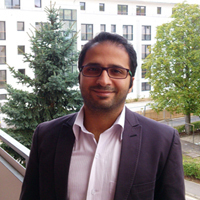An algorithm for the modeling and interpretation of Seismoelectric data
Author(s):
Abstract:
Seismoelectric modeling is a prospecting method, based on seismic electromagnetism inwhich seismic sources are used to generate this phenomenon. When seismic waves arereleased within a fluid-saturated sedimentary material, a small amount of fluid-solidrelative motion is induced. The seismic force causes this effect through a combination ofrelative gradient acceleration fluid and the pressure of seed waves. Most of the surfacegrain, in contact with a liquid electrolytes, are chemically bound to the surface load. The thin layer of charged fluid around each grain is balanced with a scattered distribution ofmobile ions with opposite charges. The scattered ions in this layer are free to movethrough the fluid so that seismic waves create an electrical current flow. This inducedseismic current flow acts as a current source in Maxwell's equations, which is the base ofelectromagnetic wave coupling with a seismic wave. The peaks and troughs thataccumulate are P-type waves. The electric field is produced inside the wave (seismic),which is vertical on the wave sinciput. This flow creates convection. In a homogeneoussubstance, the current flow is equal to convection so that the overall flow is zero; nomagnetic or electromagnetic fields are created independently., Hence, the electric fieldthat exists within the wave moves as a part of the reaction without spreading outside thewave. Therefore, a simple pair of electrodes can act as a geophone to measure the electricfield inside the P-wave when it passes throughthem. The S shear wave does not separatecharges in a homogeneous substance without divergence, so they cause no fluid repletion.The relative motion of fluid to solid is due to seed accelerations. The induced current flowcreates magnetic fields that, in turn, produce a small electric field. Thus, for S waves in aporous and homogeneous environment, a magnetic field is produced that moves as a partof the material reaction. Effluent but electromagnetic waves are not producedindependently. Supposedly, a magnetic detector (which is insusceptible to mechanicalvibration) can serve as a selector geophone on shear wave action and measure themagnetic field N-S wave when the magnet passes the gauge. The effect of a direct current(DC) electric field on the propagation of seismic waves is modeled in this study by meansof the pseudospectral time domain (PSTD) method, based on a set of governing equationsfor poroelastic media. This study focuses on the more general concept of thesiesmoelecric coupling effect and the application of poroelastodynamics and Maxwellsequation to seismic and electromagnetic waves. In this project, the magnitude effects ofseismoelectric coupling are found to be characterized by charge density, electricconductivity, dielectric permittivity, fluid viscosity and zeta potential. The simulatedporoelastic wave propagation and electric field vary with an existing background. Aphysical experiment was carried out in an oilfield using a DC electric field and the resultswere compared with those of the simluation. Estimations for solutions of differentialequations are based on the function (or a number of separate estimates for this function)defined by a certain relationship between its various derivatives on a given place or timerange along the boundary conditions of this area. Overall, this is a serious problem andonly a formula for this solution was analyzed. An alternate method with finite derivativeswas used to replace the differential equation. The results show that the seismoelectriccoupling in a wide range of the seismic frequency bands generated through a DC electricfield can significantly affect the propagation of elastic energy.
Keywords:
Language:
Persian
Published:
Iranian Journal of Geophysics, Volume:5 Issue: 1, 2011
Page:
51
magiran.com/p837885
دانلود و مطالعه متن این مقاله با یکی از روشهای زیر امکان پذیر است:
اشتراک شخصی
با عضویت و پرداخت آنلاین حق اشتراک یکساله به مبلغ 1,390,000ريال میتوانید 70 عنوان مطلب دانلود کنید!
اشتراک سازمانی
به کتابخانه دانشگاه یا محل کار خود پیشنهاد کنید تا اشتراک سازمانی این پایگاه را برای دسترسی نامحدود همه کاربران به متن مطالب تهیه نمایند!
توجه!
- حق عضویت دریافتی صرف حمایت از نشریات عضو و نگهداری، تکمیل و توسعه مگیران میشود.
- پرداخت حق اشتراک و دانلود مقالات اجازه بازنشر آن در سایر رسانههای چاپی و دیجیتال را به کاربر نمیدهد.
دسترسی سراسری کاربران دانشگاه پیام نور!
اعضای هیئت علمی و دانشجویان دانشگاه پیام نور در سراسر کشور، در صورت ثبت نام با ایمیل دانشگاهی، تا پایان فروردین ماه 1403 به مقالات سایت دسترسی خواهند داشت!
In order to view content subscription is required
Personal subscription
Subscribe magiran.com for 70 € euros via PayPal and download 70 articles during a year.
Organization subscription
Please contact us to subscribe your university or library for unlimited access!



